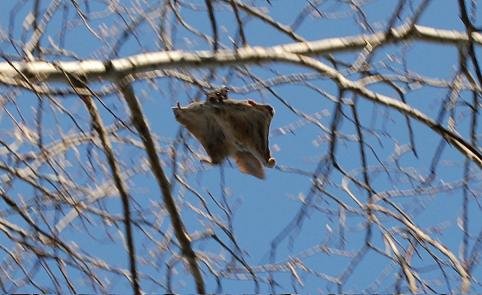Northern Flying Squirrel: Glaucomys Sabrinus

Description Of The Northern Flying Squirrel
The northern flying squirrel is a relatively small squirrel. From the tip of its nose to the tip of its tail, it measures about ten inches long. It has very large round black eyes that assist with night vision and a long flattened tail built for gliding navigation. The upper fur is soft cinnamon brown and gray, but below it has creamy white fur.
Between its front and rear feet, it has a loose fold of skin. This skin forms a kind of parachute when it stretches its legs out, allowing the squirrel to glide from branch to branch. It pulls up as it approaches its landing site, slowing its descent. It uses its tail as a rudder when it is gliding to help it change direction. 1Go To Source nhpbs.org -“Northern Flying Squirrel – Glaucomys sabrinus”
Learn More: Nuisance Squirrel Species
Northern Flying Squirrel Habitat
Usually found in regions with mostly conifers, deciduous and mixed coniferous/deciduous forests, northern flying squirrels can be relatively abundant.
Northern flying squirrels are commonly seen in regions made up of spruce, hemlock, and fir trees. They may less commonly inhabit forests with maple, white spruce, and birch trees.
Flying northern squirrels frequently nest 1 to 18 meters above the ground in conifers. They will construct nests using twigs, bark, feather, fur, and leaves. 2Go To Source biokids.umich.edu -“Northern flying squirrel Glaucomys sabrinus”
Range Of Northern Flying Squirrels
As its name suggests, the northern flying squirrel can be found within the northern United States and Canada. The species requires dense forests with tall trees allowing it to glide from tree to tree.
States that the northern flying squirrel calls home include Wyoming, Oregon, South Dakota, Massachusetts, New Hampshire, North Dakota, Idaho, West Virginia, North Carolina, Minnesota, Ohio, Alaska, California, Michigan, Nevada, Washington, Utah, Wisconsin, Virginia, Maine, Vermont, New Jersey, Montana, and New York. 3Go To Source oregonwild.org -“Northern Flying Squirrel”
Northern Flying Squirrel Diet
The flying squirrel is an omnivorous rodent. It eats mushrooms, truffles, lichens, fruits, green vegetation, nuts, seeds, tree buds, insects, and meat (fresh, dried, or rotted). Nestling birds and eggs can also be eaten.
Northern Flying Squirrel Behavior

Northern flying squirrels often form groups of eight, typically including mature and juvenile squirrels. Moreover, it has been recognized that several individuals live in the same nest. These squirrels gather in same-sex units during the winter months in order to maintain warmth.
Flying squirrels from the north are strictly nocturnal animals. During the day, they have two periods of activity: one occurs one hour after sunset, lasting approximately 2 hours, while the other starts 2 hours before sunrise, lasting 1.5 – 2 hours. Each rodent may have several dens during the year. Cavities in conifer trees are generally the winter dens of this species. Since they do not hibernate, multiple individuals may live in a single den to conserve heat during this period.
These rodents are one of the most sophisticated gliding mammals in aerodynamic terms. Although flights as long as 90 meters have been recorded, they are able to glide for as long as 5-45 meters at a time (20 average).
Vocalizations, scent, and touch are the primary forms of communication. This squirrel’s most commonly heard calls are a soft, low chirping sound and a cluck emitted when the animal feels danger. 4Go To Source animalia.bio -“NORTHERN FLYING SQUIRREL”
Reproduction Habits Of Northern Flying Squirrels
There is very little known about northern flying squirrels’ reproduction habits. Every breeding season, individuals most likely have different mates.
Courtship starts in March and can last until late May. One litter is born per year, and without the male’s help, the female raises the young. In early spring, copulation occurs and is followed by a gestation period of 37 to 42 days.
Usually, 2 to 4 young are born, although litters were recorded as small as 1 and as large as 6. Newborns are poorly developed; they have closed eyes and ears, fused toes, and a cylindrical tail and weigh 5 to 6 grams.
The toes are separated on the sixth day, and the eyes open after 31 days. At 40 days, the young leave the nest and are completely weaned after two months, although they may stay with the mother for another month. In the first summer following their birth, flying squirrels begin to breed. 5Go To Source animaldiversity.org -“Glaucomys sabrinus northern flying squirrel”
How Do Northern Flying Squirrels Glide?
Flying squirrels are gliders, not flyers. These squirrels have a special membrane between their front and back legs that enables them to glide from tree to tree.
When ready for flight, the flying squirrel launches itself from a high branch and spreads its gliding membrane to begin gliding. This species will use its legs/tail to steer during flight. More than 150 ft can be covered in one flight attempt. 6Go To Source nwf.org -“Flying Squirrels”
Top 5 Predators Of Northern Flying Squirrels
- Martens
- Domestic cat
- Coyotes
- Owls
- Hawks
Sources:
- PBS, New Hampshire. “Northern Flying Squirrel – Glaucomys Sabrinus.” NHPBS, PBS, nhpbs.org/natureworks/northernflyingsquirrel.htmhttps://nhpbs.org/natureworks/northernflyingsquirrel.htm. Accessed 25 Jan. 2021.
- Malamuth, E. and M. Mulheisen 2011. “Glaucomys sabrinus” (On-line), Animal Diversity Web. Accessed January 25, 2021 at http://www.biokids.umich.edu/accounts/Glaucomys_sabrinus/
- “Northern Flying Squirrel | Oregon Wild.” Oregon Wild, Oregon Wild, oregonwild.org/wildlife/northern-flying-squirrel. Accessed 25 Jan. 2021.
- “Northern Flying Squirrel – Facts, Diet, Habitat & Pictures on Animalia.Bio.” Animalia, Animalia, animalia.bio/northern-flying-squirrel. Accessed 25 Jan. 2021.
- Malamuth, E. and M. Mulheisen 2011. “Glaucomys sabrinus” (On-line), Animal Diversity Web. Accessed January 25, 2021 at https://animaldiversity.org/accounts/Glaucomys_sabrinus/
- “Flying Squirrels.” National Wildlife Federation, National Wildlife Federation, www.nwf.org/Educational-Resources/Wildlife-Guide/Mammals/Flying-Squirrels#:%7E:text=They%20have%20a%20special%20membrane,the%20gliding%20membrane%20is%20exposed. Accessed 25 Jan. 2021.
